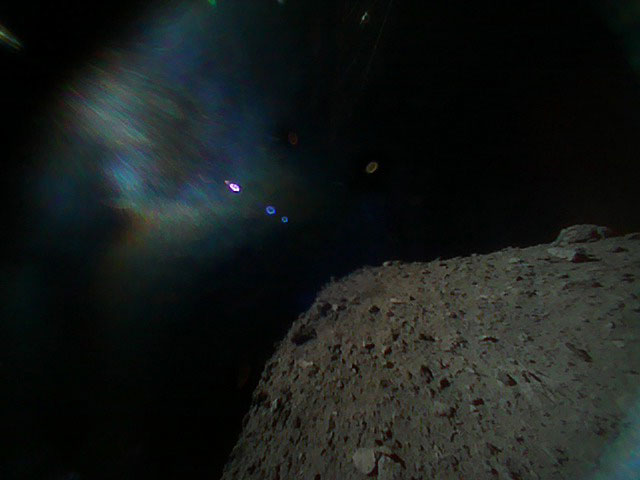Descent stations of the Hayabusa 2 mission successfully landed on the surface of the asteroid 1999 JU3

Photo taken by the rover 1B September 21 this year. The picture was taken immediately after the module was separated from the station.
On Habré several times wrote about the Japanese mission to study asteroids "Hayabusa 2". The purpose of this mission is to survey a particular asteroid, 1999 JU3, which was opened on May 10, 1999 as part of the LINEAR project, by the staff of the Socorro Observatory. To accomplish the mission, a probe was developed, which was created by the specialists of the Japan Aerospace Exploration Agency (JAXA).
As you can already understand by the name of the mission, there was the first one. In the framework of the previous project, the first Hayabusa apparatus was able to reach the Itokawa asteroid in 2005. The new asteroid is twice the size of Itokawa, its diameter is 0.92 km. In July of this year, Habyaus-2 reached the end point of its journey. Well, the other day, descent vehicles landed on the surface of the asteroid.
Descent vehicles MINERVA-II1 landed and are in normal mode. They move on the surface of the asteroid jumps, and along with them, we should expect, jumping for joy and representatives of the project team. It’s no joke - to develop a complex system designed to study an object extremely distant from the Earth, and to achieve success in this endeavor, both of which are launched, retaining their operability.
')

Photo taken by rover 1A on September 21. It is also made immediately after separation from the station. The picture was taken during the rotation of the rover, so it came out blurry
Both devices were the first in the history of space exploration rovers, which hit the surface of an astroid. The modules, Rover-1A and 1B, are hexagonal, their size is small - only 18 centimeters across. The height of each - seven centimeters, weight - 1.1 kg. The main task of the rovers is to create stereo images of the asteroid's soil. They move with the help of a hopping mechanism. In addition to photos, the modules are capable of solving other tasks, since they are equipped with optical sensors, an accelerometer, a gyroscope and thermometers.

This image was obtained by the rover of 1A on September 22. It was made in a jump, so it also turned out to be somewhat blurred. However, it is quite possible to discern the peculiarities of the asteroid's surface, which means that scientists can already draw some conclusions about the nature of this object.
Why study asteroids?
Many objects of this type are the same age as the solar system. And they seem to be frozen in development, in contrast to the planets. This means that the study of asteroids can understand what the solar system was at the very beginning of its existence, and also study the material from which the planets and satellites were formed.
Ultimately, this can help clarify how life appeared in our system.
The asteroid, on which the landed modules landed, is moving around the Solar system in a very elongated orbit. Thanks to her, the probe can easily return to Earth after the completion of the main mission. In addition, it belongs to the type of the oldest C-class asteroids in the solar system. Its representatives are characterized by a high content of carbon and hydrated rocks. The capsule with the substance of the asteroid will fall to Earth in December 2020.
Source: https://habr.com/ru/post/424159/
All Articles